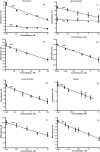A comparison of the performance of molecularly imprinted polymer nanoparticles for small molecule targets and antibodies in the ELISA format
- PMID: 27883023
- PMCID: PMC5121619
- DOI: 10.1038/srep37638
A comparison of the performance of molecularly imprinted polymer nanoparticles for small molecule targets and antibodies in the ELISA format
Abstract
Here we show that molecularly imprinted polymer nanoparticles, prepared in aqueous media by solid phase synthesis with immobilised L-thyroxine, glucosamine, fumonisin B2 or biotin as template, can demonstrate comparable or better performance to commercially produced antibodies in enzyme-linked competitive assays. Imprinted nanoparticles-based assays showed detection limits in the pM range and polymer-coated microplates are stable to storage at room temperature for at least 1 month. No response to analyte was detected in control experiments with nanoparticles imprinted with an unrelated template (trypsin) but prepared with the same polymer composition. The ease of preparation, high affinity of solid-phase synthesised imprinted nanoparticles and the lack of requirement for cold chain logistics make them an attractive alternative to traditional antibodies for use in immunoassays.
Figures



Similar articles
-
Direct replacement of antibodies with molecularly imprinted polymer nanoparticles in ELISA--development of a novel assay for vancomycin.Anal Chem. 2013 Sep 3;85(17):8462-8. doi: 10.1021/ac402102j. Epub 2013 Aug 22. Anal Chem. 2013. PMID: 23947402 Free PMC article.
-
Does size matter? Study of performance of pseudo-ELISAs based on molecularly imprinted polymer nanoparticles prepared for analytes of different sizes.Analyst. 2016 Feb 21;141(4):1405-12. doi: 10.1039/c5an02018b. Analyst. 2016. PMID: 26796951
-
Replacement of Antibodies in Pseudo-ELISAs: Molecularly Imprinted Nanoparticles for Vancomycin Detection.Methods Mol Biol. 2017;1575:389-398. doi: 10.1007/978-1-4939-6857-2_25. Methods Mol Biol. 2017. PMID: 28255895
-
Molecularly imprinted polymers with multi-functionality.Anal Bioanal Chem. 2016 Mar;408(7):1727-33. doi: 10.1007/s00216-015-8929-2. Epub 2015 Aug 9. Anal Bioanal Chem. 2016. PMID: 26255295 Review.
-
Synthetic Strategies in Molecular Imprinting.Adv Biochem Eng Biotechnol. 2015;150:1-24. doi: 10.1007/10_2015_313. Adv Biochem Eng Biotechnol. 2015. PMID: 25840705 Review.
Cited by
-
Picomolar-Level Sensing of Cannabidiol by Metal Nanoparticles Functionalized with Chemically Induced Dimerization Binders.ACS Sens. 2023 Dec 22;8(12):4696-4706. doi: 10.1021/acssensors.3c01758. Epub 2023 Dec 11. ACS Sens. 2023. PMID: 38084058 Free PMC article.
-
Biomimetic Silica Nanoparticles Prepared by a Combination of Solid-Phase Imprinting and Ostwald Ripening.Sci Rep. 2017 Sep 14;7(1):11537. doi: 10.1038/s41598-017-12007-0. Sci Rep. 2017. PMID: 28912505 Free PMC article.
-
Molecularly imprinted polymers (MIPs): emerging biomaterials for cancer theragnostic applications.Biomater Res. 2023 May 13;27(1):45. doi: 10.1186/s40824-023-00388-5. Biomater Res. 2023. PMID: 37173721 Free PMC article. Review.
-
The Amount of Cross-Linker Influences Affinity and Selectivity of NanoMIPs Prepared by Solid-Phase Polymerization Synthesis.Polymers (Basel). 2024 Feb 16;16(4):532. doi: 10.3390/polym16040532. Polymers (Basel). 2024. PMID: 38399910 Free PMC article.
-
Mycotoxins-Imprinted Polymers: A State-of-the-Art Review.Toxins (Basel). 2024 Jan 15;16(1):47. doi: 10.3390/toxins16010047. Toxins (Basel). 2024. PMID: 38251263 Free PMC article. Review.
References
-
- Vlatakis G., Andersson L. I., Müller R. & Mosbach K. Drug assay using antibody mimics made by molecular imprinting. Nature 361, 645–647 (1993). - PubMed
-
- Canfarotta F., Poma A., Guerreiro A. & Piletsky S. Solid-phase synthesis of molecularly imprinted nanoparticles. Nat. Protocols 11, 443–455 (2016). - PubMed
Publication types
MeSH terms
Substances
LinkOut - more resources
Full Text Sources
Other Literature Sources

